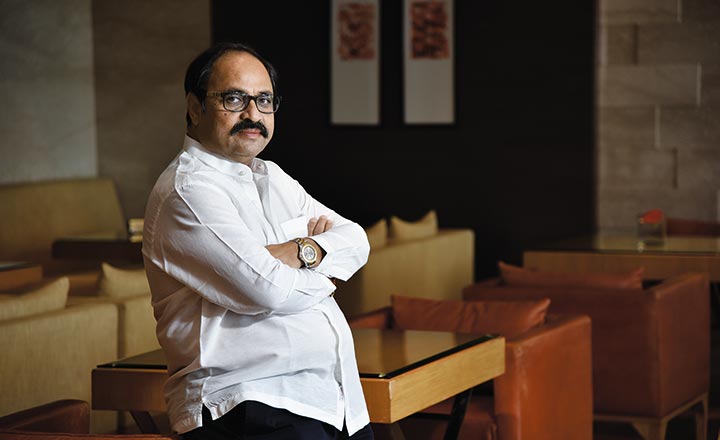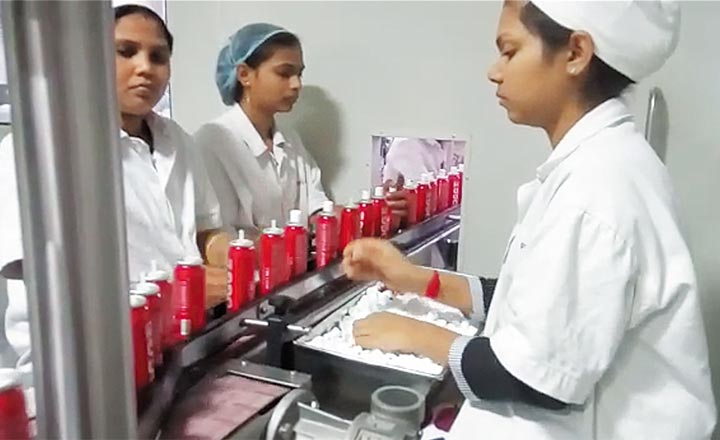Vini Cosmetics has been well and truly a disruptor in the Indian deodorant industry. By tapping into the existing gap in the market, its founder Darshan Patel decided to introduce a deodorant with a non-aerosol pump that didn’t require any gas. This resulted in the emergence of Fogg, a deodorant without gas – a first of its kind in India. Although a late entrant, it has successfully managed to reposition the way men’s deodorants have been viewed by the Indian consumer.
Consumer research was the key to finding a unique positioning for Fogg – Vini’s leading brand. Fogg managed to dethrone Unilever’s Axe which was the market leader then within two years of its launch. With a 20% market share, Fogg now rules the roost in the Indian deodorant market. Fogg has moved into women’s deodorants as well and is now also eyeing the growing Indian skincare market
Ensconced in a very comfortableblack chair with a deep cushion, Darshan Patel’s white shirt completes the picture. The table with almost no paper, has an inexpensive pen. The man speaks slowly, but is concise and crisp. He points several times to the large shelf behind him where the name ‘Fogg’ stands out. It is the brand that has made Vini Cosmetics, of which he is the chairman & managing director.
Patel speaks of Vini as his ‘second innings’ since he first cut his teeth in the family-owned Paras Pharmaceuticals in the mid-1980s. Following his differences with the family, he sold his 23% stake to private equity major, Actis in 2006 for Rs.170 crore. Patel spent the next couple of years at his 300 acre fruit orchard farm.
A phone call from a friend asking him to put his mind to better use got him thinking again. So, in 2010 he started Vini Cosmetics with an investment of Rs.60 crore. It has been a little over seven years since that conversation, and the 56-year-old has managed to create a Rs.700 crore company. With Fogg becoming the largest selling deodorant in India, the market share of more established players, took a serious hit. It managed to dethrone Hindustan Unilever’s Axe as the largest selling deodorant in less than two years. “My strength lies in identifying gaps in the market. It is what I have always done well,” says Patel without a hint of immodesty. By addressing a basic need, which always seemed to miss the attention of the incumbents, Patel created one successful brand after another like Moov, Krack, D’Cold and DermiCool for Paras.
The genesis
18+, the first deodorant launched by the company in February 2011 didn’t find too many takers. Patel wanted to understand what went wrong. So, they conducted a consumer research exercise across 35-40 groups in the top eight cities. One of the points revealed was that consumers expressed no sense of dissatisfaction with the deodorant brand they were using. A good fragrance was the most important thing for them. Patel was caught in a bind, with 18+ being another ‘me-too’ brand. “A recurring concern for most groups was that the the deodorant was getting over very quickly. Nobody was really complaining about this but it was something we decided to explore anyway,” he recalls.

In almost no time, he located a manufacturer in China, whose area of expertise was non-aerosol pumps that regulated the flow. This way, there was no wastage. Within a month, he was ready with a prototype for Patel’s “new” deodorant. “I was confident that this time, we’ve got it right with a product without gas and packaging in the form of a measured dose,” he says. The additional non-aerosal pump ensured that the deodorants lasted for 40 days, in comparison to 20 days for their competitors.
Eventually, in December 2011, their new brand ‘Fogg’ was launched. Fogg was an acronym for Friends of Good Guys/ Good Girls. There was little to doubt that Patel got it right, but what followed was a surprise, even to him. In its first month, Fogg sold 150,000 cans and 260,000 cans the following month. By the end of the fourth month, it was selling a million units. Today, Fogg sells four million cans each month, with one million being sold in markets like Dubai, GCC, Bangladesh and Nepal. In the domestic market valued at Rs.3,600 crore, Fogg has a market share of 20%, making it the largest player. Hindustan Unilever’s Axe, which had a market share of almost 20% in 2012 now accounts for just 6%. Fogg is sold at 750,000 outlets across India, apart from 5,000 wholesalers.
In March 2012, three months after the launch of Fogg, Patel launched Fogg for women. From Vini’s Rs.700 crore turnover for FY17, Rs.600 crore or 86% comes from Fogg; at a PAT level, it has been profitable over the last two years. A women’s perfume (launched a year and a half ago) and the women’s deodorant, both under the same brand, account for around Rs.140 crore, while the men’s version bringing in the lion’s share at Rs.450 crore. The company outsources manufacturing to third parties, allowing Patel to focus on marketing and brand building. Other brands in the company’s product portfolio are White Tone (face powder), Glam Up (powder cream that promises an instant glow) and Ossum (women’s perfume). White Tone which is positioned against fairness creams is the next biggest brand, making Rs.50 crore for the company.
Challenging the status quo
Patel likes to call himself a disruptor. “It is possible consumers themselves do not see a need, but I look at disruption as a way to offer a new product or a promise. It may be a costly affair but that risk has to be taken,” he says. This ability to spot that need or gap goes back to the time Patel was in Paras and his love for consumer research. Vispy Doctor, CMD, Ormax Consultants, a firm specialising in consumer research and brand consulting, seconds that. He has worked with Patel for twenty-five years now from their days at Paras. “To him, research is the beginning of strategy and everything else that follows,” he says.

Citing the case of Moov, Doctor explains how Patel would constantly probe on ways to increase usage at a time when Iodex was the dominant player. Patel positioned Moov as something that could address any ache and took market share away from Iodex. “By using Iodex on the ankle, the area covered was no more than four inches. But with Moov, it was a lot more since it was the entire back,” he adds. Krack, launched in 1993 was a result of Patel’s keen observations at Mumbai’s Churchgate station where he noticed the number of women with cracked feet. He was surprised to find no products in the market to address this problem.
Even with DermiCool, it was again research that threw up the insights. At that point, brands like Nycil and Shower to Shower, both owned by multinationals, primarily addressed the problem of prickly heat. Sensing the gap in the market, Patel instinctively knew a powder could do a lot more. “He launched DermiCool as a skin and a comfort product. Importantly, it could be used anytime unlike the others that were largely seasonal,” points out Doctor. To this day, he does not remember one conversation he has had with Patel beyond brands. “Every product he launches needs to have mass appeal. He loves simplification,” he says.
Patel is a strong believer in using simple and straightforward branding, which is evident especially in his brand names. His most recent launch, Ossum, a women’s perfume is another instance of his simplistic branding methods. “The word is used all the time by the modern generation and to them everything is awesome. We went for that name and changed the way it is spelt for more appeal,” he points out with a broad smile.
Patel’s proven track record at Paras and later with Fogg helped in raise funding. Sequoia Capital, who had invested in Paras and exited with a 4x return in 2010, backed Vini by picking up a 9% stake for Rs.100 crore in mid-2013. According to Abhay Pandey, managing director, Sequoia Capital, Patel, apart from the experience, had a very interesting proposition to break through a large and growing market. Pandey, who is on Vini’s board, expects higher growth to come from product extension and premiumisation (like perfumes) and expanding geographies. Extending the brand to other product categories is an option over time that has to be carefully evaluated,” he says. Prior to Sequoia, Bay Capital invested Rs.28 crore in Vini in December 2011, around the time Fogg was launched.
Do it yourself
Building these brands from scratch and scaling it up was a result of many things, Patel’s media strategy being a key component. “Out of sight, is out of mind. Our approach has been to put all our money on television. It gives us the widest reach, at the lowest possible cost,” rationalises Patel.
What is surprising though, is that he does all the media planning on his own, including negotiating with television channels across the country. For a company with a media spend of over Rs.100 crore in 2017, or 15% of sales as a thumb rule in Patel’s mind, (Axe spent Rs.70 crore in 2016 and Rs.120 crore in 2015) he has used television to its full potential. For instance, Fogg was launched with the commercial which showed two glasses and sprayed with deo from two cans — Fogg and a competing brand. The glass with Fogg filled up with each spray while the other glass barely did as the vapour dissipated. There was no better way to tell consumers that they were getting more bang for their buck when they bought Fogg.
Harsh Mariwala, Marico’s chairman, describes Patel as a “one man show”, who understands everything from consumer insights to how the media works, is fulsome in his praise for Patel’s acumen. “The deodorant market is competitive, crowded and dominated by multinationals. A lot of credit needs to be given to Vini for not just identifying a vacant slot in the non-aerosol space but also for creating a niche for itself,” he says. According to him, it gets even more complicated simply because of the way deodorants have been used here. “People look at it as a perfume and spray it on the clothes instead of the body, which is why it has not really worked in India. Deodorants are even now viewed as an affordable substitute to perfume,” he explains.
What next?
A visible concern is the high dependence that Vini has on Fogg but Patel waves away the thought of Vini being a one-trick pony. “It’s no different for Colgate. We need to play the brand smartly,” he says. Pandey maintains that one mega brand is more valuable than multiple brands adding up to the same revenue. “Brands like White Tone and Glam Up are slow growth product categories that will take time to gain acceptance from consumers,” explains Patel.
By any yardstick, FMCG is a business with low levels of success. Mariwala puts it as one or two successful products, for every ten products launched. “That explains why successful companies get price-earning multiples of 40 or 50. Once you succeed, it is a defensive sector and the trick is to keep trying while constantly testing one’s hypothesis,” he says. The immediate priority for Patel, apart from looking to export Fogg to newer markets like Eastern Europe, is to get cracking on skincare. “We are looking at options like skin lotion and cold cream very closely. We should be in a position to launch them by the end of the year,” he says.
In every sense, Patel has been a disruptor and that has stood him in good stead. Creating new niches successfully and growing them in his own unique way remains the hallmark of his story. If competition took on prominent personalities as brand ambassadors, he chose to build Fogg differently. “I am not saying it’s a bad idea. It’s just not a part of our brand architecture and I don’t see the logic,” he says quite bluntly. Without a doubt, there is something to learn from this success story that smells good and, with skincare, could look good as well.









 Just one email a week
Just one email a week